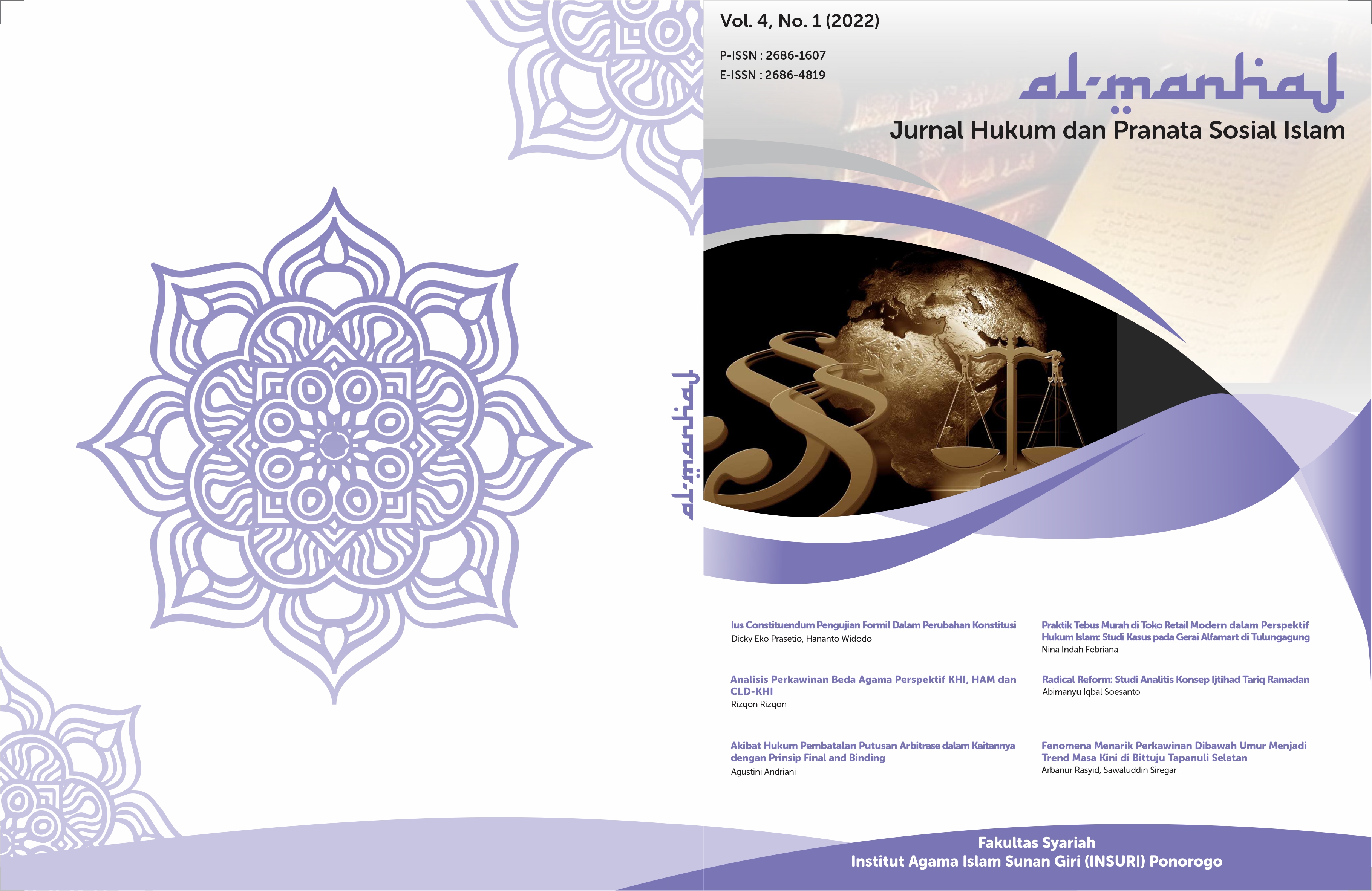Fenomena Menarik Perkawinan Dibawah Umur Menjadi Trend Masa Kini di Bittuju Tapanuli Selatan
DOI:
https://doi.org/10.37680/almanhaj.v4i1.1571Keywords:
Marriage;, Children, Adults, MinorsAbstract
This article examines the phenomenon of underage marriage in Bittuju, South Tapanuli. Many people who are still underage apply for marriage in the Religious Courts, especially because of the change in Law No. 1 of 1974 to Perma No. 5 of 2019. This research is descriptive qualitative, by conducting observations, interviews and document studies. The data analysis technique carried out by the researcher is a qualitative analysis by describing clearly and in depth the underage marriage. The results of this study conclude that underage marriages that occur in Bittuju, South Tapanuli are self-willed and factors of pregnancy outside marriage
Downloads
References
Alfa, Fathur Rahman. 2019. “Pernikahan dibawah umur Dan Perceraian Di Indonesia.” Jurnal Ilmiah Ahwal Syakhshiyyah (JAS) 1(1):49. doi: 10.33474/jas.v1i1.2740.
Amalia, Fatma. 2009. “Pernikahan dibawah umur Dalam Perspektif Hukum Islam.” Musãwa Jurnal Studi Gender Dan Islam 8(2):201. doi: 10.14421/musawa.2009.82.201-221.
Arbanur Rasyid, S. Siregar. 2022. “TikTok Becomes One of the Applications to Increase Divorce Rates in Southern Tapanuli.” 4(1).
Fadlyana, Eddy, and Shinta Larasaty. 2016. “Pernikahan dibawah umur Dan Permasalahannya.” Sari Pediatri 11(2):136. doi: 10.14238/sp11.2.2009.136-41.
Fauji Hadiono, Abdi. 2018. “Pernikahan dibawah umur Dalam Perspektif Psikologi Komunikasi.” Jurnal Darussalam; Jurnal Pendidikan, Komunikasi Dan Pemikiran Hukum Islam IX(2):2549–4171.
Julianto, Muhammad. 2015. “Dampak Pernikahan dibawah umur Dan Problematika Hukumnya.” Jurnal Pendidikan Ilmu Sosial. 25(01):72.
Kartikawati, Reni. 2015. “Dampak Perkawinan Anak Di Indonesia.” Jurnal Studi Pemuda 3(1):1–16.
Mubasyaroh. 2016. “Analisis Faktor Penyebab Pernikahan dibawah umur Dan Dampaknya Bagi Pelakunya.” Jurnal Pemikiran Dan Penelitian Sosial Keagamaan 7(2):385–411.
Musfiroh, Mayadina Rohmi. 2017. “Hukum Keluarga Dalam Perspektif Perlindungan Anak.” Journal de Jure 8(2):64. doi: 10.18860/j-fsh.v8i2.3731.
Sakdiyah, Halimatus, and Kustiawati Ningsih. 2013. “Mencegah Pernikahan dibawah umur Untuk Membentuk Generasi Berkualitas.” Jurnal Masyarakat, Kebudayaan Dan Politik 26(1):35–54.
Salmah, Syarifah. 2016. “Pernikahan dibawah umur Ditinjau Dari Sudut Pandang Sosial Dan Pendidikan.” 입법학연구 제13집 1호(May):31–48.
Siregar, Sawaluddin. 2021. “Mitos Larangan Pernikahan Semarga Di Sumatera Utara.” Jurnal Al-Maqasid; Jurnal Ilmu-Ilmu Kesyariahan Dan Keperdataan 1–21.
Siregar, Sawaluddin, and Misbah Mardiah. 2021. “Relevansi Term Kafa’ah Pada Pernikahan Adat Batak Mandailing Natal.” Jurnal Al-Maqasid; Jurnal Ilmu-Ilmu Kesyariahan Dan Keperdataan 7:290–302.
Ton, W. L. 2020. “Implementasi Batas Minimal Usia Perkawinan Berdasarkan UU No 16 Tahun 2019 Tentang Perkawinan Di Kecamatan Pasangkayu.” (16).
Yono, La., Agus, and Jumiati Tuharea. 2020. “Presepsi Masyarakat Terhadap Perkawinan Dibawah umur Di Tinjau Dari Undang-Undang No 1 Tahun 1974 Tentang Perkawinan.” Jurnal Pattimura Civic 1(1):38–47.
Downloads
Published
How to Cite
Issue
Section
License
Copyright:
- Author retains the copyright and grants the journal the right of first publication of the work simultaneously licensed under a Creative Commons Attribution 4.0 International License that allows others to share the work with an acknowledgment of the work's authorship and initial publication in this journal.
- Author is able to enter into separate, additional contractual arrangements for the non-exclusive distribution of the journal's published version of the work (e.g., post it to an institutional repository or publish it in a book) with the acknowledgment of its initial publication in this journal.
- Author is permitted and encouraged to post his/her work online (e.g., in institutional repositories or on their website) prior to and during the submission process, as it can lead to productive exchanges, as well as earlier and greater citation of the published work (See The Effect of Open Access).
License:
-
Attribution — You must give appropriate credit, provide a link to the license, and indicate if changes were made. You may do so in any reasonable manner, but not in any way that suggests the licensor endorses you or your use.
-
No additional restrictions — You may not apply legal terms or technological measures that legally restrict others from doing anything the license permits.
You are free to:
- Share — copy and redistribute the material in any medium or format
- Adapt — remix, transform, and build upon the material for any purpose, even commercially.

This work is licensed under a Creative Commons Attribution 4.0 International License.














